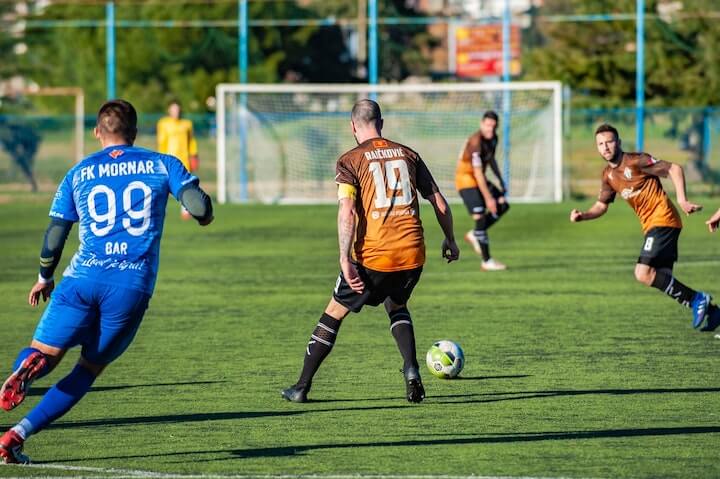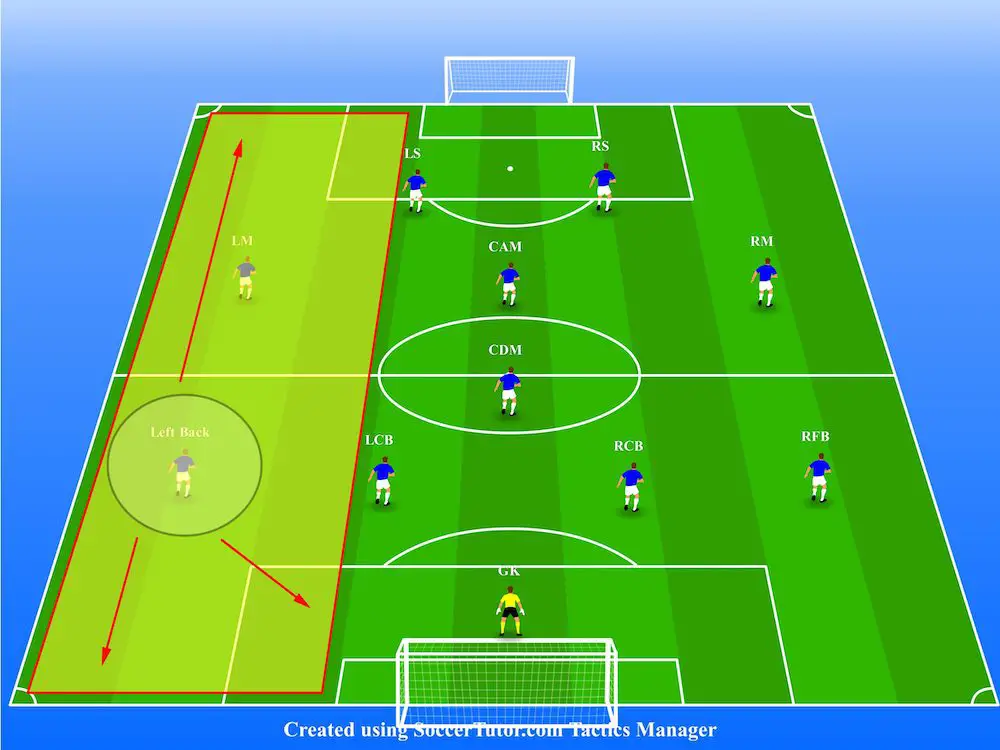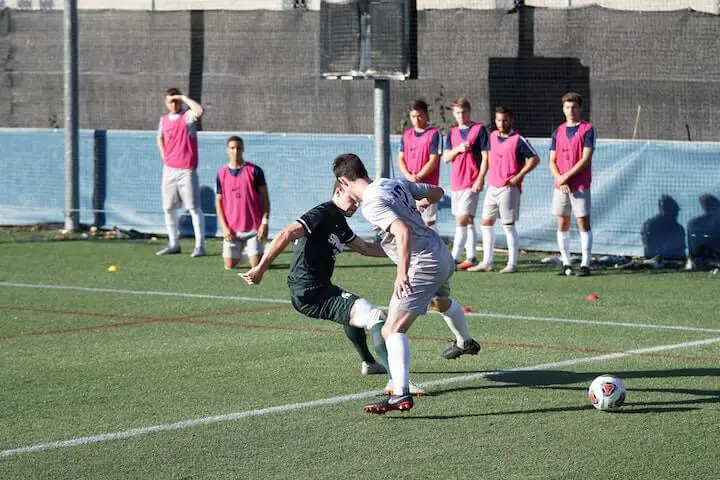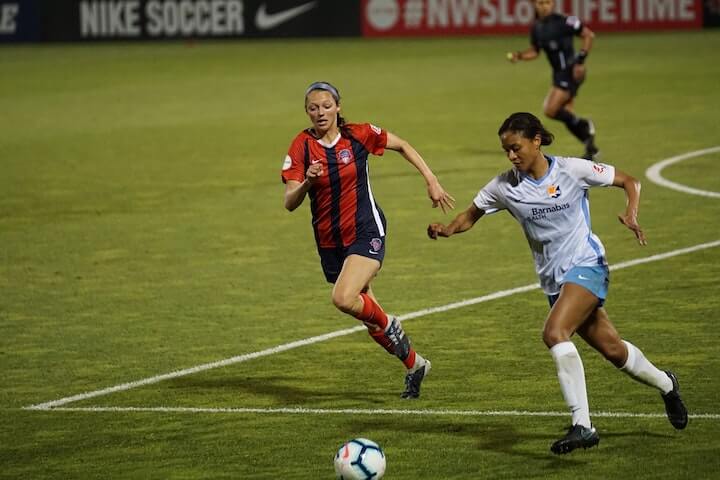What is a Left Back in Soccer? (Full Position Guide)
Historically, the left back in soccer was one of the least influential on the field.
Apart from occasional outliers like Roberto Carlos, left backs were quite one-dimensional. Defending first and offering attacking support second.
Teams could get away with putting mediocre players in fullback positions.
But now the sport has evolved...
In today's game, fullbacks have a much greater influence over defensive shape, ball retention, and attacking strategy.
In an increasingly technical game, there's no more room for passengers.
Successful teams have dominant players in every single position, including left back.
What is a Left Back in Soccer?
A left back in soccer is a defender who plays on the left side of the backline, usually forming part of a back four.
Modern left backs have attacking and defensive responsibilities and are far more well-rounded than in previous generations.
Their first job is to defend their side of the field. Stopping attacks from wide areas and covering back post runs when the ball is on the opposite flank.
Positioning and awareness are essential traits of an effective left back. They must be in the right place at the right time to cut out any danger or receive a pass from a teammate.
Soccer IQ can help players overcome many weaknesses, whether they lack a yard of pace or don’t have the physical strength to dominate strikers.
However, as the sport develops further, the technical standards in every position are increasing.
Left backs must have solid defensive fundamentals to deal with quick-footed wingers and powerful strikers.
Having good on-the-ball skills, like dribbling, passing, crossing, and first touch is a major advantage in the final third.
It’s no secret that people regard the best left backs in the world as such because of their abilities to deliver in attack as well as defense.

Position of a Left Back in Soccer
A left back's territory runs the entire length of the field along the left sideline.
Since their main job is to defend, they spend most of their time inside their own half.
That said, in dominant possession-based teams like Barcelona or Manchester City, you'll often see the fullbacks push on and operate primarily in their opponent’s half.
When their team has possession, the left back typically hits the sidelines, maximizing space and stretching the opposition.
While out of possession, the left back squeezes in to create a more compact backline.
If their direct opponent, usually the winger, gets on the ball, the left back must defend their territory 1v1.
But when the ball is on the opposite side, they tuck infield to plug any gaps.
Left backs are responsible for their back post when the ball is on the other side of the field.
It’s imperative that their head is on a swivel and they communicate with teammates to minimize threats from late runners.

Inverted Left Backs
Pep Guardiola regularly uses inverted fullbacks to align with his philosophy of central dominance and midfield control.
Rather than hugging the touchlines in the build-up phase, at least one of the fullbacks moves into a central position which creates a numerical advantage.
The added numbers allow midfielders and inverted fullbacks to make several quick passes, progressing the ball through the center of the field.
This is a highly effective way to break a traditional press.
However, it requires long hours on the training field to account for all scenarios. Simple mistakes will lead to easy chances for the opposition team.
To play as an inverted left back, a player must have excellent technical ability as well as great positional awareness.
There's no room for complacency with inverted left backs.
It's a high-risk, high-reward strategy.
Inverted fullbacks often play on the opposite side to their strong foot so they can cut inside onto their favored foot.
Joao Cancelo is the perfect example of an inverted left back, dominating for Manchester City in the 2021/22 season.
What Does a Left Back Do in Soccer?
The role of a left back in soccer (or right back) has developed more than many others in the past decade.
With each passing season, coaches ask more and more of their fullbacks.
Here’s a look at the main roles of a left back in and out of possession.
Left Back's Role In Defense
#1 - Defend Their Territory
Left backs play a key role in a four-player backline.
Their primary responsibilities are:
- Defend the left flank
- Mark the opposition winger
- Disrupt any attacks that occur in their quadrant.
A left back must have solid defensive fundamentals to deal with tricky midfielders and quick forwards who use skill and speed to create goalscoring opportunities.
Left backs often find themselves in 1v1 situations where they have to match their opponent in terms of speed and physicality.
Dominant fullbacks can effectively shut down opposition attackers by forcing them away from the goal, blocking crosses, and winning 50/50 duels.
#2 - Offer Defensive Cover
While a left back’s main role is to defend, they must also provide effective cover if the ball is on the opposite wing.
When the opposition attacks down the right side, the entire defensive line shifts across to cover any immediate threats and prevent crosses.
In this instance, the left back tucks in to act as the last line of defense if the ball makes its way into the box.
Positional sense and awareness are critical in these situations.
The left back must track the ball while keeping an eye on their winger and late runners to the back post.
That's why the key to defensive covering as a fullback is correct body positioning.
A left back should open their body toward the play and be able to point at the ball and their winger with either hand.
#3 - Maintain the Defensive Shape
A dominant defensive line works as a unit.
During training sessions, coaches often use bands to connect each defender. This ensures they all move as one and maintain a solid defensive shape.
A disjointed backline leaves gaps for the opposing team to exploit.
Left backs must be in constant communication with their center backs to keep the shape.
While in possession, the left back is typically whitening their cleats along the sideline, moving up and down the wing to offer a passing outlet.
Out of possession, the left back tucks in 10 to 15 yards to reestablish a solid defensive shape.
The winger drops back to offer cover in the wide areas and track any overlapping runs.
If you’ve ever seen a live game, you may have noticed that the defenders are constantly talking (screaming), making sure they plug all the gaps and everyone is in the right position.
Left Back's Role In Attack
#4 - Help Their Team Build From the Back
The vast majority of modern teams adopt a build-from-the-back strategy.
This means electing to hold on to possession and develop attacks slowly, rather than pumping long passes hoping someone will get on the end of it.
Since fullbacks usually get more time and space on the ball than other players, they’re crucial for recycling possession and exploiting any gaps that pop up.
This is where having a good on-the-ball skill set comes in.
Top left backs should not only be capable of receiving and giving passes, but they must also have the vision, confidence, and ability to venture forward and create.
#5 - Develop Relationships with Wingers
In addition to forging bonds with fellow defenders, left backs must also develop relationships with the wingers on their team.
The left back and left winger attack and defend in tandem, creating mismatches and overloads when they are in possession.
Fullbacks and same-sided wingers should know each other’s strengths, weaknesses, tendencies, and habits.
This ensures they can flow between attack and defense seamlessly and work together to create goalscoring opportunities.
Give-and-go passes, dummy runs, and overlaps are key actions in a fullback-winger partnership.
#6 - Orchestrate Attacks
In the modern game, left backs are becoming more influential in the opponent’s final third.
4-3-3 formations are the most popular setups among elite teams, with fullbacks providing essential width in attacking scenarios.
If the left back takes up an advanced position, the left winger is free to attack central areas and occupy the opposing defenders.
Jurgen Klopp’s Liverpool is a perfect example of how to utilize fullbacks to orchestrate attacks.
Their primary fullbacks, Trent Alexander-Arnold and Andrew Robertson, have consistently led their team’s assist charts over the past five seasons.
Trent, in particular, is widely regarded as one of the most technically gifted creators in the Premier League.
Despite criticisms about his lack of defensive abilities, he can drop the ball on a dime and is easily one of Liverpool’s most dangerous attackers.

7 Key Traits of a Left Back in Soccer
Left backs are a special breed…
While there are always outliers in sports, you can usually spot a left back from a mile away.
They're akin to bulldogs on the field, displaying ferocious intensity, a strong work ethic, and excellent stamina.
To dominate as a left back, you must hone your skill set to develop the following traits:
a. Technical Defending
Fiery left backs usually have an aggressive approach, putting their bodies on the line where most others wouldn’t.
However, elite-level defenders display a fine balance of physicality and technical mastery.
"Technical defending" refers to tackling capabilities (standing and sliding), blocking, heading, and first touch.
A good left back should be able to outwit their opponents in 1v1 situations by demonstrating patience and timing.
The best defenders are rarely caught square.
Instead, they show their opponents one direction (away from the goal), stacking the odds of winning the duel in their favor.
In addition to stopping opponents, dominant left backs should be able to cut out attacks and crosses in a controlled manner.
This can involve redirecting crosses or clearing dangerous balls into safe areas for teammates.
b. Positioning and Movement
Top-class positioning and movement ensure a defender remains a step ahead of their opponent.
As discussed, a left back works as part of a defensive unit and rarely strays from the backline.
A dominant left back makes the game look easy and relies on strategic positioning and movement to snuff out attacks.
c. Aggression
Fullbacks are notoriously feisty.
Aggression and tenacity are common traits among left backs.
Although technique and positional sense are increasing in importance, physicality and aggression are crucial in a position where there are so many individual battles.
d. Good Reading of the Game
A single lapse in concentration by any defender can result in a goal.
Fullbacks can sometimes get away with poor positioning due to central cover from other defenders.
However, a left back can’t rely on teammates to make up for their mistakes.
A dominant defender must be able to read the game, anticipate runs, and position themselves correctly to break up attacks.
At a professional level, a player can improve their ability to read the game by studying tape and analyzing trends by opposing wingers.
The key aspects of a good film session involve studying regular running and dribbling patterns, where the opponent likes to receive the ball, and where they like to pass.
These factors allow the defender to anticipate attacks and close down opponents in the right places at the right times.
In amateur competition, players won’t have access to hours of tape on their opponents. Instead, they can make reads in-game, while practicing solid fundamental positioning.
If they notice particular trends, they can adapt and make adjustments to combat them.
e. Stamina
A left back is one of the rare positions that involves spending an entire game running the length of the field.
To dominate as a left back you must have excellent stamina to last a full 90 minutes.
What’s more, you must also be able to perform well until the very last second.
For example, failing to track a winger in the closing moments can result in a free header at the back post, potentially costing the team a win.
Again, instilling good habits and a strong positional sense ensures a left back is in the right position more often than not.
If you’re struggling to keep up toward the end of a game, always defend first.
Never take unnecessary risks that could contribute to your team losing the contest.
f. Speed
A high-level modern left back should also be fast.
As well as keeping up with speedy wingers, they often have to chase down over-the-top passes, cut out through balls, and cover for teammates.
Interestingly, two of the fastest players in today’s game are fullbacks.
Alphonso Davies, the Canadian left back from Bayern Munich, clocked a staggering 22.68 mph in 2021.
While PSG’s blistering right back, Achraf Hakimi, logged 22.66 mph in the same season.
This is approximately 4 mph away from the fastest 100m sprinters in the world every year.
Not bad considering the conditions are much more difficult on grass while wearing cleats.
Speed kills on the soccer field.
g. Striking Technique
Many teams rely on their left backs to create attacking opportunities.
Possessing high-level striking technique can take your game to another level, allowing you to make goalscoring chances from wide areas.
In many cases, left backs begin their careers as wingers but lack the offensive qualities to make it in the professional leagues.
However, if they retain the ability to whip in a good cross, switch the play, or shoot from distance, they can be extremely useful to their teams as defenders.
We often see left backs assume free-kick and corner-taking duties.
Best Left Backs of All Time
Learning from the greats is one of the best ways to elevate your game and truly dominate as a left back in soccer.
Here is my list of the best left backs of all time to give you some inspiration:
- Roberto Carlos
- Paolo Maldini
- Ruud Krol
- Nilton Santos
- Giacinto Facchetti
- Denis Irwin
- Bixente Lizarazu
- Paul Breitner
- Antonio Cabrini
- Ashley Cole
Some of the best of the modern greats include:
- Marcelo
- Jordi Alba
- David Alaba
- Patrice Evra
- Alphonso Davies
- Andy Robertson
- Luke Shaw
- Lucas Hernandez
- Theo Hernandez
- Ferland Mendy

5 Bonus Tips for Left Backs
At the highest level, fine margins decide games.
If you want to gain an edge over your competition, pay attention to these 5 pro tips for dominating as a left back:
Tip #1: Build an Engine
Countless matches have gotten turned on their heads due to last-minute heroics.
In general, the team with the freshest players comes out on top in the closing moments.
Left backs can affect games on both ends of the field, so when other players are tiring, make sure you’re still in the fight by developing a big gas tank.
You can achieve this by going for runs on off days, hitting the gym during the week, or simply working harder and pushing your limits in training.
Just make sure you don’t overtrain or run the risk of injury.
Tip #2: Work on Striking Technique
Fullbacks often find themselves in dangerous attacking positions.
By refining your striking technique, you can learn to punish your opponents when given the time and space.
Set up extra training sessions to work on crossing, shooting, and long passing.
You’ll see the difference on game day.
Tip #3: Situational Training
Fullbacks frequently get judged on how they deal with 1v1s and deep crosses to the back post.
Although some have a natural instinct in these scenarios, most players don’t.
Situational training helps you get comfortable in 1v1 duels and gives you confidence in intense defensive phases.
Talk to your coach about running through 1v1 drills or situational training in some of your weekly sessions.
Alternatively, you can round up some teammates and put in some extra hours outside of practice.
Tip #4: Study Tape
All pro players study tape on the opposition to prepare for upcoming games.
While you may not have access to footage of your opponents, you can research videos on the world’s best players.
Check out some defensive highlights on top-level left backs. Pay attention to important skills, like positioning, body shape during 1v1s, and tackling technique.
Take note of areas you can improve on and try to implement them in your training.
Tip #5: Expand Your Game
There has never been a better time to be a left back in soccer.
Teams rely on them to consistently influence the game and encourage them to get forward and attack.
Once you’ve reached a good level with defensive fundamentals, expand your game and become a true force in your position.
In addition to core defensive skills, work on dribbling, changing direction on the ball, offensive 1v1s, and using your weak foot.
Well-rounded fullbacks are in extremely high demand in the modern game.
Conclusion
It’s no longer acceptable to ignore a left back in soccer.
Dominant left backs are highly skilled going forward or backward and are often the key difference at the highest level.
Refine your technical skills and master positioning to improve and excel in this niche position.

